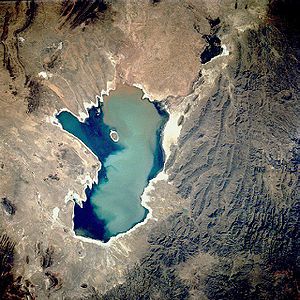Poopó lake
| Poopó lake | ||
|---|---|---|

|
||
| Satellite image 1991 | ||
| Geographical location | Bolivia | |
| Tributaries | Desaguadero River | |
| Drain | Río Laca Jahuira (temporarily) | |
| Islands | Isla de Panza, 14 others | |
| Places on the shore | Poopó , Challapata , Huari | |
| Data | ||
| Coordinates | 18 ° 33 ′ S , 67 ° 5 ′ W | |
|
|
||
| Altitude above sea level | 3686 m | |
| surface | 1 340 km² | |
| length | 84 km | |
| width | 53 km | |
| volume | 4.02 km³ | |
| Middle deep | 3 m | |
| Catchment area | 27,700 km² | |
The Poopó Lake is approximately 1,340 km² large salt lake in the Andes in Bolivia . The authorities officially declared the lake to be dry in December 2015, and in February 2017 it was largely replenished by heavy summer rain.
The still water , which is located southeast of Lake Titicaca about 50 km south of Oruro at an altitude of 3686 m in a drainless basin of the Andes, is fed by the Río Desaguadero , the outflow of Lake Titicaca. The average depth of the lake is 3 m.
Emergence
The Poopó lake emerged about 10,000 years ago from the 43,000 km² large Tauca lake , a glacial body of water that comprised the three sub-basins of today's Poopó lake, the Coipasa salt lake and the Salar de Uyuni and a water depth of up to 60 Meters. The heavily muddy water of Lake Poopó is a habitat for flamingos .
Dehydration and resuscitation
Due to a lack of water supplies, the lake was almost completely dry in 1994. Since December 2015, scientists no longer counted on regeneration.
In February 2017, the lake was filled up to 70% of its original level within a few days due to heavy rain. Around 30% of the surface remained dry and parts of the original fauna have returned.
After the water area had increased further to 1,400 km² in June 2018, 100,000 young earfish were released to revive the lake ; the reintroduction of carp is planned. Fishing resumed prematurely towards the end of 2018 after the water level fell again and the salt content of the lake rose , leading to fears that the fish would die out.
Individual evidence
- ↑ Albrecht Kessler. Reconstruction of the late glacial climate and water balance on the Peruvian-Bolivian Altiplano (1984) (PDF; 1.01 MB)
- ↑ Troy A. Blodgett, Bryan L. Isacks, John D. Lenters. Constraints on the Origin of Paleolake Expansions in the Central Andes (1996)
- ↑ Renace el Poopó: el segundo lago más grande de Bolivia recupera el 70% de sus aguas tras secarse. Crónica de Chihuahua, February 26, 2017
- ↑ Patricia Barriga Flores: Lago Poopó vuelve a la vida con la siembra de alevines de pejerrey. El Fulgor from June 24, 2018
- ^ Adelantan la pesca en el lago Poopó por la salinidad y la reducción de agua. Los Tiempos from October 30, 2018
Web links
- How the salt lake in the Andes became a desert Die Welt of January 22, 2016
- Bolivia's Lake Poopó Disappears



